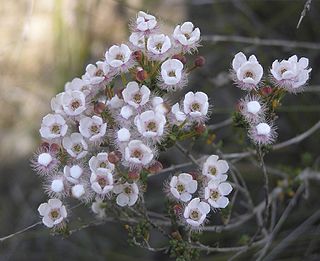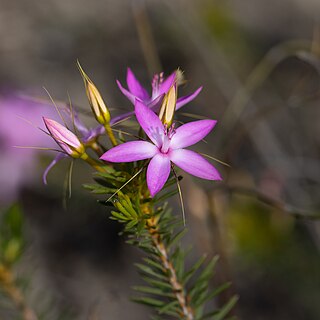
Chamelaucium, also known as waxflower, is a genus of shrubs endemic to south western Western Australia. They belong to the myrtle family Myrtaceae and have flowers similar to those of the tea-trees (Leptospermum). The most well-known species is the Geraldton wax, Chamelaucium uncinatum, which is cultivated widely for its large attractive flowers.

Verticordia eriocephala, commonly known as lambswool, and common, native or wild cauliflower is a flowering plant in the myrtle family, Myrtaceae and is endemic to the south-west of Western Australia. It is a shrub with one densely branching, spreading main stem, small leaves and dense heads of creamy-white flowers, giving rise to the common names "lambswool" and "cauliflower". It is widespread over its range but becoming less common because of land clearing and illegal collecting of the flowers.

Verticordia plumosa, commonly known as plumed featherflower, is a flowering plant in the myrtle family, Myrtaceae and is endemic to the south-west of Western Australia. It was the first species in the genus to be described, although initially given the name Chamelaucium plumosum. It is a shrub with linear leaves and rounded groups of scented pink, mauve or white flowers. Two varieties of this species have been declared as being "threatened".
Verticordia albida is a flowering plant in the myrtle family, Myrtaceae and is endemic to the south-west of Western Australia. It is a shrub with one main stem with many branches and spike-like groups of scented, white feathery flowers with a pink centre.
Verticordia auriculata is a flowering plant in the myrtle family, Myrtaceae and is endemic to the south-west of Western Australia. It is a small, multi-branched shrub with small leaves and spikes of pink to magenta-coloured flowers in late spring to early summer and it is widespread in the wheatbelt.
Verticordia capillaris is a flowering plant in the myrtle family, Myrtaceae and is endemic to the south-west of Western Australia. It is a shrub with a single stem at the base, small leaves and creamy white or occasionally pink flowers in dense corymb-like groups. It is common in small areas near Geraldton.

Verticordia habrantha, commonly known as hidden featherflower, is a flowering plant in the myrtle family, Myrtaceae and is endemic to the south-west of Western Australia. It is a slender shrub with short, leafy side-branches and long flowering stems with rounded heads of mostly white flowers. Its hairy sepals are mostly hidden by the round, unfringed petals, and as a result, the plant looks like shrubs in the genus Chamelaucium, to which it is closely related.
Verticordia harveyi, commonly known as autumn featherflower, is a flowering plant in the myrtle family, Myrtaceae and is endemic to the south-west of Western Australia. It is a slender, spindly shrub with relatively long leaves and small white, pink or magenta-coloured flowers in late summer and autumn.

Verticordia is a genus of more than 100 species of plants commonly known as featherflowers, in the myrtle family, Myrtaceae. They range in form from very small shrubs such as V. verticordina to trees like V. cunninghamii, some spindly, others dense and bushy, but the majority are woody shrubs up to 2.0 m (7 ft) tall. The flowers are variously described as "feathery", "woolly" or "hairy" and are found in most colours except blue. They often appear to be in rounded groups or spikes but in fact are always single, each flower borne on a separate stalk in a leaf axil. Each flower has five sepals and five petals all of a similar size with the sepals often having feathery or hairy lobes. There are usually ten stamens alternating with variously shaped staminodes. The style is simple, usually not extending beyond the petals and often has hairs near the tip. All but two species are found in Southwest Australia, the other two occurring in the Northern Territory.

Verticordia monadelpha is a flowering plant in the myrtle family Myrtaceae, and is endemic to the south-west of Western Australia. It is a much-branched shrub with pink to magenta flowers in spring and early summer. It is commonly known as pink Morrison, woolly featherflower, pink woolly featherflower, white woolly featherflower or pink cauliflower.
Verticordia verticordina is a flowering plant in the myrtle family, Myrtaceae and is endemic to a small area near the coast of the south-west of Western Australia. It is a small, low-growing shrub with crowded leaves and in spring, scattered pale greenish-cream and golden brown flowers. Its unusual flowers and fleshy leaves give the plant a superficial resemblance to a Darwinia.

Verticordia densiflora, commonly known as compacted featherflower, is a flowering plant in the myrtle family, Myrtaceae and is endemic to the south-west of Western Australia. It is a shrub with small leaves, usually small pink and white flowers and which is widespread in the south-west of the state. It is a variable species and in his 1991 paper, Alex George formally described five varieties.

Verticordia humilis, commonly known as small featherflower, is a flowering plant in the myrtle family, Myrtaceae and is endemic to the south-west of Western Australia. It is a small shrub with leafy branches and scattered, mostly red flowers hanging loosely near the ends of the branches.

Verticordia inclusa is a species of flowering plant in the myrtle family, Myrtaceae and is endemic to the south-west of Western Australia. It is a small shrub with small, thick leaves and groups of scented, mostly white to pale pink flowers with a red centre on the ends of the branches in spring.
Verticordia minutiflora is a flowering plant in the myrtle family, Myrtaceae and is endemic to the south-west of Western Australia. It is a bushy shrub with small, crowded, cylindrical leaves and groups of white to pale pink flowers in summer and autumn. As suggested by its botanical name, it has the smallest flowers of any verticordia.
Verticordia paludosa is a flowering plant in the myrtle family, Myrtaceae and is endemic to the south-west of Western Australia. It is an openly branched shrub with small leaves and pink to magenta flowers with spreading, feathery sepals and erect, fringed petals in summer and autumn.
Verticordia polytricha, commonly known as northern cauliflower, is a flowering plant in the myrtle family, Myrtaceae and is endemic to the south-west of Western Australia. It is an erect, bushy shrub with linear leaves and dense heads of white flowers in late spring and summer.
Verticordia serotina is a flowering plant in the myrtle family, Myrtaceae and is endemic to the north-west of Western Australia. It is a shrub with egg-shaped leaves and bright pink flowers with long, curved styles in spring.
Verticordia vicinella is a flowering plant in the myrtle family, Myrtaceae and is endemic to the south-west of Western Australia. It is a shrub with narrow leaves and groups of small, scented, pink or pale yellow flowers, growing near Esperance and in the Cape Arid National Park.

Calytrix decandra, commonly known as pink starflower, is a species of flowering plant in the myrtle family Myrtaceae and is endemic to the south of Western Australia. It is a semi-prostrate, glabrous shrub with linear to narrowly elliptic leaves and pink, mauve or magenta flowers with usually 10 stamens in a single row.











